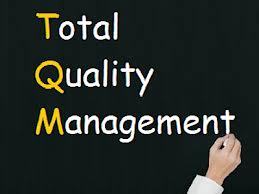Total Quality Management (TQM) is an enhancement to the traditional way of doing business. It is a proven technique to guarantee survival in world‑class competition. Only by changing the actions of management will the culture and actions of an entire organization be transformed. TQM is for the most part common sense. Analyzing the three words, we have
Total ‑ Made up of the whole
Quality‑ Degree of excellence a product or service provides.
Management‑ Act, art, or manner of handling, controlling, directing, etc
Therefore, TQM is the art of managing the whole to achieve excellence. The Golden Rule is a simple but effective way to explain it: Do unto others as you would have them do unto you.
Basic Concepts of TQM
While there are significant differences among the theorists and their approaches to implementation, they share basic concepts that are the foundation of TQM.
Continuous Improvement of Quality:
Fundamental to all TQM systems is improving the quality of the products and services provided by an organization. Such quality improvement results in greater productivity and enhances the ability of an organization to remain vital, employ people, and serve customers. A focus on continuous quality improvement helps an organization do things right.
Central Focus on the Customer:
Also central to all TQM is a focus on the customer, the internal and external recipients of an organization’s products. Their needs and desires define quality for the producer whose job it is to meet or exceed the customer’s needs and expectations. A focus on customers helps an organization to do the right things.
Systematic Improvement of Operations:
All work occurs in processes that begin and end somewhere. These work processes account for 80- 85 percent of the quality of work and productivity of employees. Management is responsible for systems within an organization; therefore, managers, not employees, must shoulder blame when something goes wrong with the system.
TQM calls for studying work processes quantitatively, using individuals or teams, to find places that breakdowns or unnecessary complexities occur in processes, and then to identify solutions that prevent them in the future. Study of work processes helps to reduce costs while ensuring that quality is built into a service or product since quality cannot be inspected into it at the end of the processes.
Open Work Environments:
Continuous quality improvement requires an atmosphere for innovation where suggestions for improvement are solicited and respected and where supervisors and managers are open to disagreement, conflict, and challenge. Activities for the improvement of work processes, especially when teams are involved, help to break down barriers that occur between departments or between supervisors and those supervised.
Long- Term Thinking:
TQM is also characterized by long- term thinking which helps mold the future by understanding the consequences of current actions. Such thinking requires decision making that is based on data, both hard and soft, and related to real problems, not symptoms. It requires time. It shies away from quick fixes arrived at by discussion and intuition. Long- term thinking works best in organizations where managers plan to stay, and thus have a stake in the consequences of their decisions.
Development of Human Resources:
Organizations that follow TQM principles are organized to help people do their jobs; they are seriously committed to employee learning and development. Such development begins with a thorough orientation to the organization, including its mission, values, and information about where the job fits into the organization. It involves educating people to perform to the quality standards of a specific job before requiring them to work independently.
TQM expects managers to respect the ability of well trained employees to know the work they do better than anyone, and therefore, to be the best at improving it. Human resource development includes providing the training to learn the communication, quantitative, and team- participation skills required in an open, quality improvement work environment. Development programs provide extensive education to help individuals keep up- to- date on their jobs and to prepare themselves for new responsibilities.
Management Responsibility for TQM Leadership:
Managers need to lead the transformation of the organization to the new culture of continuous quality improvement. They must accept personal responsibility for continuous quality improvement and be dedicated to empowering others in the organization to accept personal responsibility for it, too. This approach taps the collective genius of the organization to identify and solve problems. The leader’s focus is on policy, structure, and systems to sustain continuous quality improvement. Within this context, quality is the first among equals of the organization’s functions. Quality is at the top of the agenda for every meeting, every communication. The leader’s goal is to help people, things, and machines do a better job; the leader’s role is that of facilitator, catalyst, and coach.
As previously stated, TQM requires a cultural change. The TQM state for typical quality elements. This change is substantial and will not be accomplished in a short period of time. Small organizations will be able to make the transformation much faster than large organizations.
















